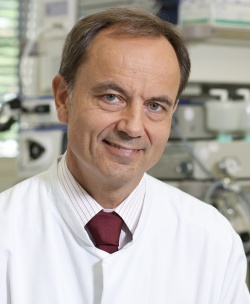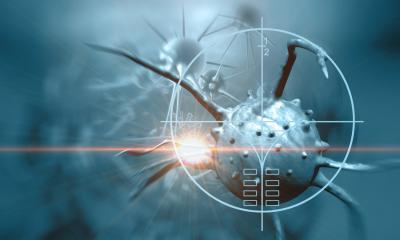Gentle intervention
Endoscopy jumps the boundaries
‘Health insurers should keep a tighter rein on the quality of endoscopic interventions because, mostly, they represent a gentler alternative to surgery,’ asserts international expert Horst Neuhaus, during an EH interview.
Report: Daniela Zimmermann/Juliane Dannert

For many people a cancer diagnosis means little chance of a cure and considerable limitations to life, as they know it. However, many patients, particularly those with gastro-intestinal cancers, can be helped by early detection. In the future, this will possibly also apply to Type 2 diabetics, of which there are more than seven million in Germany alone. During our interview with internationally renowned endoscopist Professor Horst Neuhaus, Senior Consultant for Internal Medicine at the Evangelical Hospital in Dusseldorf, he spoke of innovations in digital endoscopic imaging technology that are used to improve diagnosis and treatment for patients.
Figures from the German Cancer Research Centre show that the country’s cancer mortality rate has been decreasing over recent years. One reason for this are improvements in early detection, for instance of colon cancer. Almost one in three screenings reveals patient polyps, Neuhaus explained. ‘The more thoroughly a doctor examines, the more he will find and the lower the risk of the patient developing cancer, despite a colonoscopy.‘One quality criterion for the examination procedure is the adenoma detection rate. It quantifies the frequency with which a doctor discovers an adenoma during an endoscopic examination. For people aged 50 and over, this, as confirmed by studies, should be over 15% for women and more than 25% for men.’
Quality reflects experience
Modern and innovative endoscopes, as well as the endoscopist’s experience, are critical for successful early detection, Neuhaus said. ‘In my view, the quality of the endoscopist is one of the most important criteria. A high resolution endoscope is necessary but cannot compensate for a bad endoscopist.’ The adenoma detection rate is a good quality criterion to assess a doctor’s work in colon cancer prevention. ‘In other areas, such as endoscopic interventions in the oesophagus, things become more complex. In Germany, any doctor, even those who have only limited experience with therapeutic endoscopy are at liberty to do advanced procedures,’ he said. ‘It would definitely be in the interest of patients and health insurers to keep a tighter rein on the quality of these interventions because, mostly, they represent a gentler alternative to surgery.’
Neuhaus believes that the increasing use of the latest endoscopic procedures clearly improves the prognosis for patients along with the quality of treatment. At the same time, however, the respective responsibilities in medicine shift. One example of this is microscopic endoscopy: ‘If you carry out an MRI scan in a 60- to 70-year-old patient you will discover cysts in the pancreas in about 10% of the cases.
Not all of these will be malignant of course, but it is not always possible to determine this with certainty in individual cases. The risk however can be assessed with modern endosonographic procedures, such as contrast-enhanced ultrasound, or a cyst puncture to analyse the content. In selected cases in the context of studies this latter technique involves insertion of an ultra-thin catheter into the cyst. This allows us to produce endomicroscopic images with a resolution equivalent to what the pathologist sees under the microscope, i.e. current data indicate that we can diagnose safely and can classify our findings as malignant or not. ‘However, it doesn’t always have to be endomicroscopy.’ The new, high-resolution endoscopes are helpful in the early detection of cancer of the digestive tract because we have long-standing training in the recognition of changes to the structure of mucosa and vessels; the key word here being neo-angiogenesis.’
For Neuhaus and team the endoscope offers a gentle method to complement biopsies with interventional imaging diagnostics. ‘When the image has been produced it obviously needs to be assessed. Studies and Working Groups that classify the images, and pathology colleagues who take a look at the images, are helpful here. ‘Cooperation with colleagues is very important because, in early stages of cancer in different organs, including the oesophagus, stomach, pancreas and others, there’s always a certain percentage of patients who will have to undergo surgery. The patient benefits from the fact that we can offer everything in one location.’
Diabetes – a new area for endoscopy
The teamwork also continues with diabetologists, with whom Neuhaus, in partnership with the medical technology industry and in the context of international multi-centre trials, is working on a new procedure to treat Type 2 diabetics. ‘‘Half of all diabetic patients have a raised HbA1c level. We know that patients with a gastric bypass, where the surgeon connects the remaining part of the stomach with the small intestine and therefore disconnects the duodenum, not only lose weight but also that their diabetes improves.
One of the reasons for this appears to be the “switching off” of the duodenum. Its mucosa produces metabolic hormones, incretins, which are believed to stimulate insulin secretion and to play a crucial role in the development of Type 2 diabetes. Details of the pathogenesis are currently being investigated. If we relate this finding to Type 2 diabetics it seems likely that we can help these patients through a “reset” of the mucosa in the duodenum which re-regulates the production of metabolic substances,’ the professor explained. ‘This is where the endoscope comes into play – by helping the doctor to insert a special balloon in to the duodenum, heating it and ablating the mucosa. The duodenal mucosa regenerates, but then appears to have different characteristics from the original one,’ he said, summarising the result of a pilot study in a Chilean hospital.
In Europe this new procedure is currently being tested in several clinical centres including, in Germany, the Evangelical Hospital in Dusseldorf. Two other German hospitals will also participate. The basis for this advance in intervention is the continuous technology development. ‘It’s not only about the camera but also about the control and mobility of the endoscope, which has to be thin enough to enter the smallest channels. In addition, without a very good flushing function we cannot carry out any surgical interventions,’ Neuhaus said, mindful of the interest in cooperation with the industry. ‘The devices need to be tested and developed further, and engineers regularly visit to watch us at work. With them we discuss future technologies based on clinical need.’
To promote the international exchange on procedures and technologies, many years ago Neuhaus founded the International Endoscopy Symposium, held annually in Dusseldorf. What’s on the 2016 agenda? ‘Our work increasingly revolves around treatment and intervention, but also good diagnostics must not be neglected. The new possibilities offered by interventions under endoscopic ultrasound guidance are particularly exciting. In one endoscopy session they allow examining several organs and positioning stents to create anastomoses, for example between stomach and small intestine. Moreover, new opportunities to carry out endoscopies of the entire small intestine, or to position medication in a targeted fashion in certain organ sections or tumours certainly will be on the 2016 agenda.’
PROFILE:
Senior Consultant of the Medical Clinical at the Evangelical Hospital Dusseldorf since 1995, Professor Horst Neuhaus MD has his scientific and clinical focus set on diagnosis and treatment of particularly early cancer stages of the intestinal tract, diseases of the biliary tract and pancreas, as well as diagnostic and therapeutic endoscopy. He is involved in several international studies in close cooperation with German and international centres and hospitals. He also hosts the International Endoscopy Symposium in Dusseldorf, considered one of the world’s largest and most important congresses within the discipline.
01.07.2015











